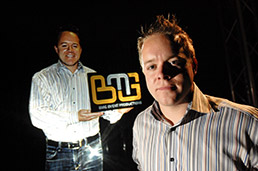Subscriber Benefit
As a subscriber you can listen to articles at work, in the car, or while you work out. Subscribe NowBattery maker Energizer gathered its marketing brains in St. Louis earlier this year for a little recharging.
Suddenly, a giant version of the drum-beating Energizer Bunny mascot zipped across a darkened, 40-foot-wide stage. Then he did head flips that would impress a rabid dog.
 Which is the real Pat Sechrist? The BMG Event Productions executive is on the right, while his holographic image hovers on the left. (IBJ Photo/ Perry Reichanadter)
Which is the real Pat Sechrist? The BMG Event Productions executive is on the right, while his holographic image hovers on the left. (IBJ Photo/ Perry Reichanadter)Only this wasn’t a guy in a pink suit—it was a holographic light projection that dissolved to reveal an Energizer executive sitting before the audience. Those who experimented with illegal drugs in the 1970s might have sworn it was a flashback.
“For the first time, they were able to bring the mascot alive on stage,” said Pat Sechrist, executive producer of Indianapolis-based BMG Event Productions, sounding alarmingly like Dr. Frankenstein.
Sechrist and his technicians have in the last few years used technology to inject drama into a convention and meeting industry mired in the economic malaise. Corporate travel budgets have been slashed, yet companies like BMG need to keep the dollars flowing in.
“People are definitely looking for the bigger, the newer and the different when it comes to effects,” said Betsy Jaffe, spokeswoman for InfoComm International, which hosts a big audio-visual trade show.
Holographic effects are still a novelty on the trade show circuit, though. Some have seen them at Disney World or at various entertainment venues in Las Vegas.
But Sechrist is thinking big, a la Cecil B. DeMille.
He’s traveled the world as far as Copenhagen for the best gadgets, and particularly for the right material on which the holographic images are projected. For the Energizer Bunny bit, for example, he needed a fabric nearly invisible to the audience yet stout enough to run the width of the stage.
The technology also involves robust versions of DLP projectors, which use tiny mirrors to reflect light onto the screens of projection TVs. It’s smoke and mirrors, in a literal sense, as smoke is blown onto the stage to produce a ghostly look and to enhance the three-dimensional aspects.
That effect came in handy for a Delta Faucet meeting in Indianapolis to discuss a new product design concept. BMG hired an actor who looked and talked like one of Delta’s founding fathers and videotaped the man discussing a similar design challenge early in the company’s history.
During the presentation, a ghostly image of the company founder materializes on the stage and starts talking. At one point, an image of a chair flashes onto the stage and the projected man walks over and sits on it. (There’s a demo on the company’s website.)
“It just blew their minds,” Sechrist said of the audience reaction. “We still, to this day, get production companies around the world trying to figure out how we did it.”
The type of imaging BMG and other firms are using is actually “pseudo-holography,” which involves projecting a high-contrast image onto a nearly invisible screen, said Jeff Allen, a Hawaii-based pioneer in holographic effects. His work in diffraction optics includes holographic records for Capitol Records and Warner Bros.
Although the effects used by BMG and other production firms aren’t true holograms, “it is a good effect,” Allen said.
Sechrist sees them as more than razzle-dazzle. They allow a company to display in realistic form products or devices that today reside only inside a computer program.
For example, BMG created a holographic effect for an IndyCar meeting on the next generation of open-wheel race cars. Hovering above the stage were various iterations of the new car chassis, spun around in virtual 3D. Side pods and wings came on and off.
“We can now present a physical object onstage before it’s actually created,” Sechrist said. “Holography will become a much bigger part of our business.”
But demand might not hit full stride until the economy picks up. Generally, it costs $10,000 to $100,000 for a holographic presentation. The amount of production work required typically determines the price. “It’s a great tool that brings products to life on stage.”•
Please enable JavaScript to view this content.
